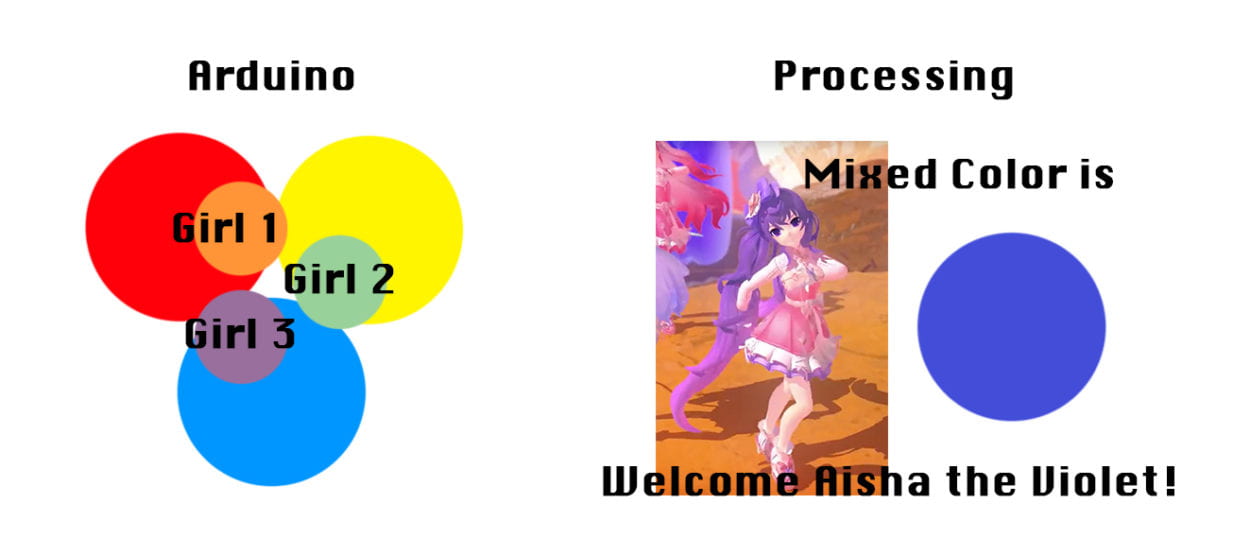Won Color el Stage
1. Project Description
It’s both a video game and a three-player strategic game. Each player acts as a supporting fan respectively of one of the three anime girl idols. Each player inputs his representative primary color and tries to summon his own idol.
2. Project Details
Player 1 inputs red trying to summon the tangerine girl.
Player 2 inputs yellow trying to summon the emerald girl.
Player 3 inputs blue trying to summon the violet girl.
How does a player inputs his color? A distance sensor from Arduino measures the distance of his hand from it. The closer, the higher the input.
How are the girls summoned? Taking those primary color inputs and computing through some lousy maths, three players get a mixed color. Then the new color is judged onto hue, to turn out to be closest to the color tangerine, emerald, or violet, and the corresponding girl switches the girl previously on stage, if there’s been, to appear on the stage to sing and dance. In practice, the animation is the girl’s video played on Processing.
Why these specific colors, and why not RGB? One idea is that I was taught by art teachers from primary school the primary colors were red, yellow, and blue. Now, I’ve acknowledged that RGB are the correct three primary colors, and CMY aren’t equal to blue, red, and yellow. Even so, I try to recover the good old memories of mixing colors in art classes. Another idea is that RGB is just to saturated, and their invert colors, CMY feels like sex and hormone, therefore, there’re not proper to represent the girl idols. By contrast, my RYB and their mixed colors are more moderate:
R+Y = orange (tangerine)
Y+B = green (emerald)
B+R = purple (violet)
How to judge victory of the game? Over the time of an idol pop song being played on the stage on Processing, the total on-stage reign of each idol is counted. Here’s a penalizing mechanism if three players are inputing so harsh that the mixed color is too dark, all girl idols black out for a moment since “there’s too much dark energy”, and each player’s time account gets reduced by the color’s darkness times the proportion of his contribution to the color. Who has the longest time wins.
How strategic can this game be? Highly. Because to earn a high score, the players have to not only explore the theoretic rules for color mixing, but also balance with the other two players to output the color of his idol, which is never easy, plus the penalizing mechanism restriction.

3. Context & Significance
It’s a supreme gift for ACG (anime, comic, and game) lovers. They can watch the cute anime girls perform as they compete, and how they input the color is intended to be like intimately touching the girl since the sensor will be decorated with the girl’s portrait. Plus, the strategic game is highly interactive.
Inspirations from midterm suggests that a multi-player game satisfies a high-ordered interaction. And players are also interacting with the virtual characters. The color idea was triggered by Click Canvas on creative applications.
4. Explanation for the Project Title
“Won” means “to win” in English and “primary” in Korean. “El” means “from” as an affix and is short for “Elsword” an ACG action RPG made by KOG Korea where the three girl idols are from. It basically means winning a game from selecting primary colors to control stage performances.
One Reply to “Fnl Prjct: Essay by ChangZhen from Inmi’s Session”